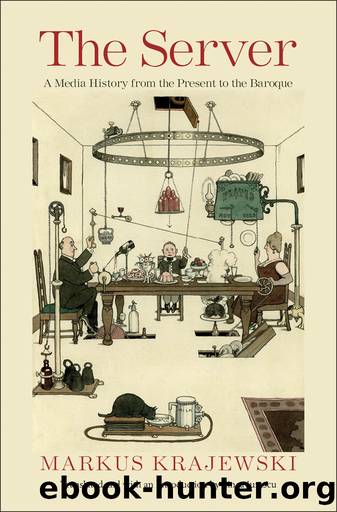The Server by Markus Krajewski

Author:Markus Krajewski [Krajewski, Markus]
Language: eng
Format: epub
Publisher: Yale University Press
Published: 2018-09-15T00:00:00+00:00
Figure 9. Media competition: Michelmann and the telegraph line
5.1.1.1. First Approach: Media History
From a media-historical perspective, one can focus on the subject of electrical telegraphy as a technical medium. Here, the discussion concerns the history of science: Ohmâs law from 1827, which Gauss intends to use in his experiments, or Faradayâs induction law from 1831. In the same context, one can also analyze the field of electricity research during the first half of the nineteenth century via the preliminary investigations of Ãrstedt and Faraday.7 But Gaussâs and Weberâs experiment can also be regarded as exemplary for a theoretical analysis. Starting from here, one can then assess the analytical scope of various communication models, from Lazarsfeld to Laswell. If one opts for the information theory model of Claude Shannon and Warren Weaver8 instead, then the components of the media dispositif (sender, receiver, channel, and noise) can be easily recognized.
By applying minimal modifications, Gauss and Weber transform their measuring instruments into a sender, consisting of a âtransmitter with induction currents,â and a receiver (more specifically, a unifilar magnetometer made out of a âmagnetic baton with multiplicator and mirrorâ).9 But the actual innovation is the transmission wire, which is much longer than those used by Soemmering and Schilling von Cannstatt in their experiments in Munich and St. Peters burg, respectively. One can truly speak of long-distance writing in this case. For the first time the Göttingen experiments from 1833 demonstrate the practical applicability of electrical telegraphy. As Gauss correctly assumes, telegraphy could be âbrought to a level of perfection that would defy the imagination. The emperor of Russia might instantly send orders to Petersburg and Odessa or even to Kiachta without the aid of relays.â10 Significantly, the scene brings together two different paradigms of transmission that would, from then on, follow distinct paths of development. But for a brief moment, information and event coincide. Michelmannâs trajectory as well as the circulation of the telegram, but especially the arrival of the message, marks the brief coincidence of two distinct modes of conveyance: an instance of analog transmission of (verbal) signs and a case of digital transfer. The success of the experiment renders the classic analog service obsolete. After only a brief period of latency, electrical communication begins its unstoppable march to victory with this transmission of digital signs.
The sentence âMichelmannâs hereâ can be uttered in unison. On the one hand, it is an instance of analog verbal transmission, announcing the message the servant has received. Via the utterance of the speech act, that message validates the truth contained in the separate and simultaneous arrival of the telegram. On the other hand, the telegram carries a digitally coded message conveying nothing less than the arrival of an analog communication. In other words, Michelmann conveys himself: as both a message and a bodily medium. As in all the previously unsuccessful attempts, the subaltern serves as the carrier of the message that can optimize the media dispositif of the telegraph. This time, however, the message cancels out
Download
This site does not store any files on its server. We only index and link to content provided by other sites. Please contact the content providers to delete copyright contents if any and email us, we'll remove relevant links or contents immediately.
Web Development with Julia and Genie by Ivo Balbaert & Adrian Salceanu(7000)
State Management with React Query by Daniel Afonso(3890)
Eleventy by Example by Robinson Bryan;(3789)
Architecting Vue.js 3 Enterprise-Ready Web Applications by Solomon Eseme(3583)
Building Python Web APIs with FastAPI by Abdulazeez Abdulazeez Adeshina(3422)
Digital Marketing with Drupal by José Fernandes(2888)
State Management with React Query by Afonso Daniel;(1520)
Building Data Science Applications with FastAPI by François Voron(1413)
Becoming an Enterprise Django Developer by Michael Dinder(1300)
Building Python Web APIs with FastAPI: A fast-paced guide to building high-performance, robust web APIs with very little boilerplate code by Abdulazeez Abdulazeez Adeshina(1232)
Operator Training Simulator Handbook by Joseph Philip(1215)
Practical WebAssembly: Explore the fundamentals of WebAssembly programming using Rust by Sendil Kumar Nellaiyapen(1131)
Hands-on Cloud Analytics with Microsoft Azure Stack: Transform Your Data to Derive Powerful Insights Using Microsoft Azure by Prashila Naik(1130)
Google Workspace User Guide: A Practical Guide to Using Google Workspace Apps Efficiently While Integrating Them With Your Data by Balaji Iyer(1109)
Building SPAs with Django and HTML Over the Wire: Learn to build real-time single page applications with Python by Andros Fenollosa(1070)
Modern Frontend Development with Node.js by Florian Rappl(992)
High Performance with Laravel Octane by R. Butti(973)
Kubernetes Design Patterns and Extensions by Onur Yilmaz(961)
JavaScript from Frontend to Backend by Unknown(877)
